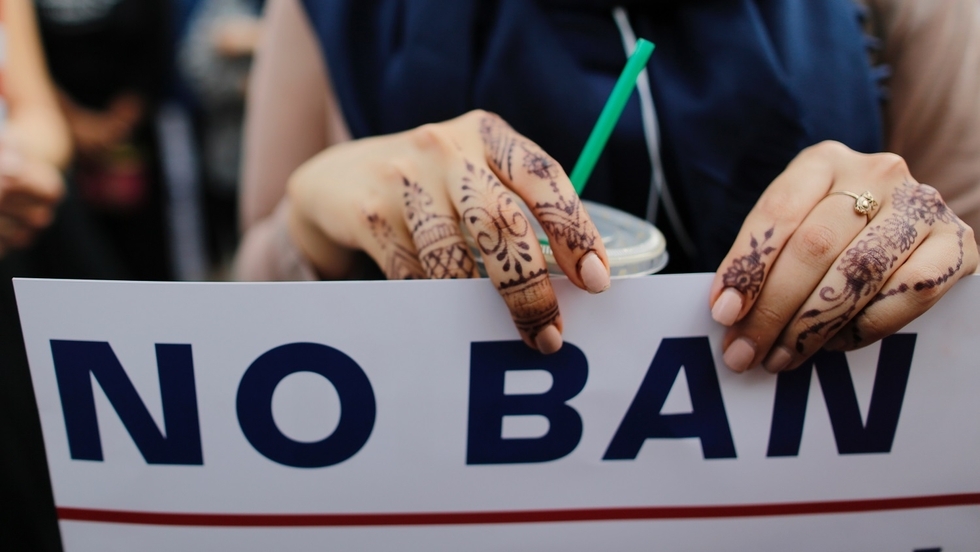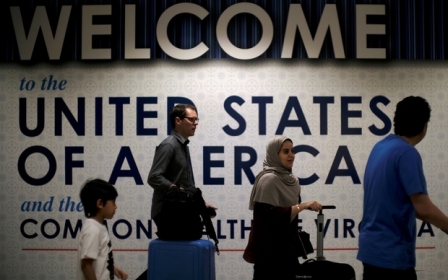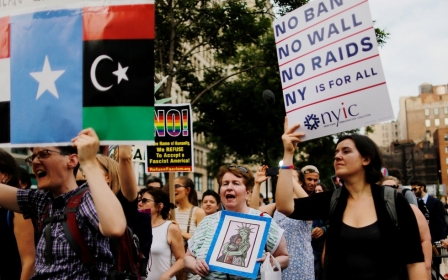ANALYSIS: Trump's 'Muslim Ban' one year on

NEW YORK, United States – One year after putting pen to paper on the Oval Office desk, US President Donald Trump has so far failed to achieve the promise he made during his election campaign of a "total and complete shutdown of Muslims entering the United States".
But the first of several orders that he signed on 27 January last year, which critics have collectively dubbed the "Muslim ban," nonetheless augured a slowdown in arrivals to the US from the world's almost 50 Muslim-majority countries.
Immigration lawyers told Middle East Eye that the Trump administration was forging ahead in spite of its legal challenges, using bureaucratic means to reject or stall arrivals from foreigners that it deems religiously undesirable.
"Aside from the real emotional, psychological harms and stereotypes that these policies are perpetuating, there's also real concrete harm in terms of who is and who is not being allowed to come into the country," Johnathan Smith, legal director of Muslim Advocates, told MEE.
"Clearly that's being felt disproportionately by Muslims or people who are perceived to be Muslims by the US government."
Numbers tell the story
From March to October last year, when Trump's travel bans were tied up in court, 21 percent fewer tourist, student and other non-immigrant visas were approved for people in Muslim-majority countries compared with the same period in 2016, according to State Department data.
The number of immigrant visas fell by 13 percent in those same months. Notably, this decrease bucked a trend of the decade preceding Trump's 2016 election year, which saw the number of visa approvals grow by 8-9 percent annually.
Refugee data tell the same story more vividly. Muslim refugee flows fell 94 percent in the January to November period last year – again, against a backdrop of Muslim refugee admissions that increased by about 18 percent each year in the decade up to 2016.
Former president Barack Obama answered the global refugee crisis by expanding US intake to 110,000 in 2016. In September, Trump cut that number to 45,000 and told a journalist that persecuted Christians should go to the front of the line.
While in theory waivers exist, applicants aren't informed about this and they have little meaning or effect in practice
- Avideh Moussavian, National Immigration Law Center
Avideh Moussavian, a lawyer for the National Immigration Law Center, told MEE that Trump administration officials are "grinding the system down" so that visa and refugee applications from foreign Muslims are vetted harder than before, "slow-walked" and rejected.
"The only explanation for denials, in most cases, is simply form-letter language saying the entry of parents, spouses, refugees and other loved ones may pose a threat to national security or public safety," Moussavian said.
"While in theory waivers exist, applicants aren't informed about this and they have little meaning or effect in practice."
Casting rejections aside, many other people don't even bother applying nowadays, added Cecillia Wang, a lawyer with the American Civil Liberties Union (ACLU). Trump's "message of condemnation of Muslims" rings loud and clear across the Middle East, she told MEE.
Mariko Hirose, a lawyer with the International Refugee Assistance Project, agreed. The administration has managed to reduce Muslim arrivals to the US even though judges had ruled against it many times this past year, she told MEE.
Those legal challenges began only hours after Trump's first travel ban by executive order on visitors, immigrants, and refugees from Iran, Iraq, Libya, Somalia, Sudan, Syria, and Yemen last January, causing chaos at airports and an international wave of protests.
Legal activists pointed to Trump's anti-Muslim comments and said the ban unconstitutionally targeted a faith, securing court rulings blocking its implementation. Trump reframed the ban in subsequent edicts, adding the non-Muslim countries Venezuela and North Korea.
The billionaire insists the ban and "extreme vetting" are needed to protect Americans from terrorists – a view that is shared not just by immigration hardliners and Trump loyalists, but by as many as six in 10 American voters, according to one poll.
Trump points to Uzbek immigrant Sayfullo Saipov, 29, who ploughed a truck along a New York bike path on Halloween, killing eight people; and the Bangladeshi taxi driver Akayed Ullah, 27, who set off a home-made pipe bomb strapped to his body in a crowded underpass last month.
Judicial showdown
In December, the Supreme Court let the latest incarnation of the ban come into full effect. The showdown is in April, when the conservative-majority body hears arguments on whether the ban violates federal law or the US constitution. A ruling will follow by the end of June.
Judges will likely wrangle over the president's responsibility to protect Americans, Trump's Muslim-bashing on Twitter and his administration's efforts to work with foreign governments to vet those seeking entry to the US.
Early indications suggest they could be more open to Trump's ban than the lower courts. A US State Department spokesperson declined to comment on changes to consular procedures in majority-Muslim countries.
For Mohamad Mashta, it is all too clear how the Supreme Court should rule. The electrical engineer from Aleppo, Syria, came to the US in 2012 and was granted asylum. He spent the past year struggling against the ban so that his wife can be granted permission to travel from Sudan and join him in Ohio.
"It felt like I was being sent a message – people like me were no longer welcome here," Mashta, 34, told MEE.
After months of nail-biting bureaucracy, the couple won its legal fight and was reunited in October. But Mashta has other relatives who wish to visit the US; he worries about the pending court ruling and more anti-immigrant policies.
"We're always worried about what's going to happen next under this administration and the legal system. Will it leave them an opening to start classifying other people to go back? Can they reject people who were granted asylum or temporary protected status?" he asked.
Mashta is not alone. The ACLU has gathered many stories of "families separated, weddings postponed and lives uprooted," showing how the ban particularly hits Muslim Americans with loved ones overseas.
Mashta and the immigrant rights advocates all vowed to continue pushing back against the administration, and one-year anniversary rallies against the ban are planned in New York, Boston, Washington and elsewhere.
But the future of Muslim immigration to the US now rests squarely in the hands of a right-leaning Supreme Court and an administration that still has three years left in the West Wing to turn Trump's campaign rhetoric into reality.
New MEE newsletter: Jerusalem Dispatch
Sign up to get the latest insights and analysis on Israel-Palestine, alongside Turkey Unpacked and other MEE newsletters
Middle East Eye delivers independent and unrivalled coverage and analysis of the Middle East, North Africa and beyond. To learn more about republishing this content and the associated fees, please fill out this form. More about MEE can be found here.




